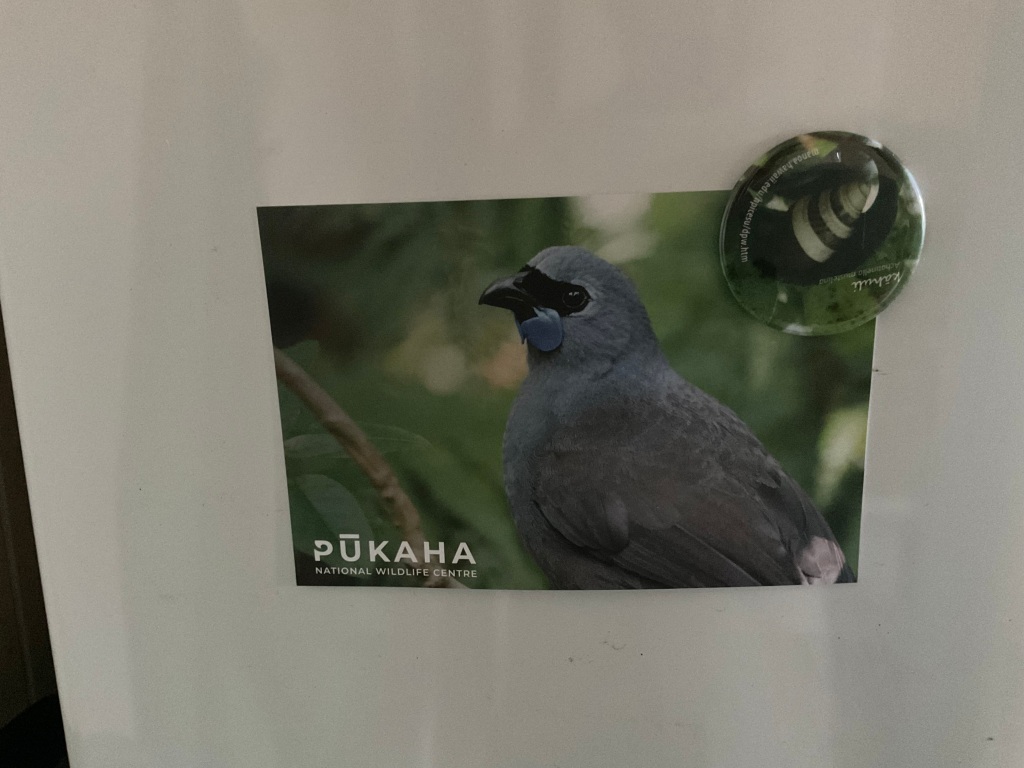
I was sadden when I heard of the passing of Kahurangi, the only kokako in captivity. While she may be gone her species, and family really, have been making a steady comeback from the brink of extinction.
When my wife and I had our honeymoon in New Zealand back in Nov 2019, we made a point to visit various conservation sites and projects throughout the North Island. Considering the conservation work I do here in Hawai`i, I wanted to see how they go about their business in Aotearoa. Needless to say, I was quite impressed. And much to our joy, each place through serendipity had a different taxa of bird stand out. Kahurangi, the female Kokako at Pukaha, was one of those special bird encounters.
Kokako (Callaeas wilsoni) was a species that I was super keen to come across in New Zealand. Part of the legendary wattlebird radiation, these along with the endangered saddleback and extinct huia are only found in Aotearora. For as much as we looked though, we didn’t come across any kokako at either Tiritiri Matangi or Maungatautari. But I wasn’t too glum; I knew when we headed down to Wellington we would visit Pukaha.
Pukaha National Wildlife Centre had a long history with Kokako conservation. Like many of New Zealand’s endemic birds, Kokako were susceptible to introduced mammalian predators and habitat loss. Their populations were in steep decline and had already been extirpated from the South Island. If things stayed on the same trajectory, the North Island species would soon follow. But the captive breeding and conservation efforts have helped, with Pukaha playing a key role. They have seemed to find even greater success with managing threats in protected forests, moving away from intensive captive breeding efforts. Now with help, the North Island Kokako populations are steadying climbing.
When we purchased our admissions tickets, I mentioned to the staff how much I wanted to see a Kokako. They were confident: “Oh you’ll see her alright. Kahurangi loves men with glasses and a beard!” I, bespectacled with a couple weeks worth of beard growth, was hopeful but skeptical. Would this bird really be that interested? Well see for yourself, here is the video I took of us approaching Kahurangi’s enclosure:
I was just hoping for a clear shot of a kokako. To have one this engaging was such an honor. And if you are interested, Kahurangi was hand-reared, and apparently the main person interacting with her was a bearded researcher with glasses.
In protected forests of the North Island with active conservation management, Kokako numbers have been increasing. Saddlebacks too have been responding well to predator control. New Zealand, a site of so much avian loss, has seen some impressive gains and done much to secure the populations of their remaining native birds. The thought of interactions like this in New Zealand backyards is now a realistic possibility. I’d like to imagine that encounters like this from Kahurangi herself helped engage the general public in New Zealand.
Seeing the hopeful signs with conservation in Aotearoa steeled my resolve to continue doing work in Hawai`i. I want to see what the future of our endemic biota with help will look like. Farewell Kahurangi, I hope you resting well with your Huia, Adzebill, and Moa brethren. We will gladly take up that mantle and keep making native places strong.

I remember seeing this bird when we were at Mt Bruce several years back. It was only the second time I’d ever seen a kokako myself, despite being raised in New Zealand. The first time had been a released bird on Tiritiri Matangi near Auckland, and at that time I was slightly taken aback at how big it was. The visit to Mt Bruce has stuck in my mind because of another unexpected moment, when the kokako tilted its head at us and said, very audibly and distinctly, ‘kokako’.
Ha, this is what i get for never reading your bio closer. I thought you were from and also worked in Australia! Yeah, she was amazing. Hearing a kokako saying her own name so clearly was a unforgettable experience. Oh, and FYI, there’s an invertebrate and plant forum going on right now in Hawai`i. A couple researchers are presenting the findings they’ve had at our restoration site with Drosophila, Amstra ground snails and native Hawaiian urticaceae. Fun times!
Pingback: The weka of Kapiti Island | Studia Mirabilium